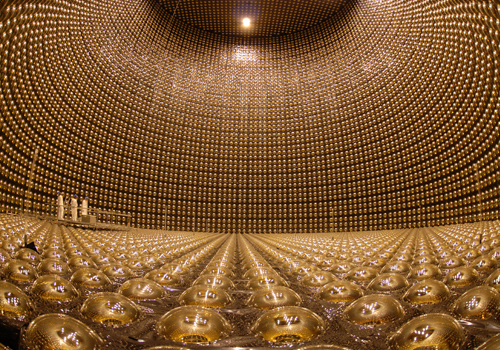When we look out at our universe of planets, stars and galaxies, we are looking at a universe that should not exist.
According to our understanding of how the cosmos began, equal amounts of matter and anti-matter were created in the Big Bang nearly 14 billion years ago. For every proton there was an anti-proton; for every neutron there was an anti-neutron; and so on.
And — just as Star Trek taught us — all that matter and anti-matter should have completely self-annihilated leaving empty space filled with nothing but photons.
For decades, physicists have been searching for an explanation for why that didn’t happen and why instead we live in a universe dominated by matter with next to no anti-matter. In other words, why are there galaxies, stars, planets and people when there should be nothing?
One possible explanation was found in a difference — an asymmetry — between quarks and anti-quarks, the fundamental subatomic particles that are the building blocks of protons and neutrons. As a result of such an asymmetry, one quark in every billion quark-antiquark pairs avoided annihilation.
However, this quark/anti-quark asymmetry isn't large enough to account for all the matter we see today.
Why is the universe the way it is?
In a paper published in the journal Nature earlier this year, a team of physicists reported the best evidence yet for an asymmetry between neutrinos and anti-neutrinos that could explain our matter-dominated universe.
The team includes particle physicist John Martin, a professor emeritus, and PhD student Trevor Towstego — both from the Faculty of Arts & Science’s Department of Physics.
As a particle physicist, Martin has spent his career plumbing the depths of the sub-atomic world. The pursuit often involves smashing particles together in order to understand what they’re made of — a process somewhat like throwing two clocks together and examining the debris to figure out how they work.
The research into neutrino and anti-neutrino asymmetry finds Martin at the intersection between the micro- and macro-universe. “I certainly come to this research from a particle physics point of view,” he says. “Cosmology, the study of the universe as a whole, is not my field at all. But particle physics and cosmology are becoming more and more connected.”
Three flavours of particles

Neutrinos are ghostlike subatomic particles — millions of times less massive than electrons — that interact with other particles so rarely that they can routinely pass through an entire planet as if it wasn’t there. Neutrinos are generated in the nuclear reactions inside stars — including the sun — and fill the universe. One hundred trillion of them pass harmlessly through our bodies every second; in our lifetimes, only one will interact with an atom inside of us.
There are three types or “flavours” of neutrinos and anti-neutrinos — muon, tau and electron — and the particles change, or oscillate, between flavours.
Oscillation of electron neutrinos from the sun was first discovered by physicists working at the Sudbury Neutrino Observatory (SNO) — a result that culminated in a share of the 2015 Nobel Prize for Canadian physicist Art McDonald. Observations of the same phenomenon conducted by five other teams — two of which included Martin — garnered the 2016 Breakthrough Prize in Fundamental Physics.
As described in the Nature paper, Martin and his collaborators discovered that muon neutrinos and anti-neutrinos did not oscillate into electron neutrinos and anti-neutrinos in identical fashion; in other words, they detected an asymmetry — one that could explain why the particles didn’t all self-annihilate in the moments after the Big Bang.
The physicists made the discovery with an experiment known as T2K, for Tokai to Kamiokande. At the Japan Proton Accelerator Research Complex (J-PARC) in Tokai, Japan, they generated beams of muon neutrinos and anti-neutrinos which traveled 295 kilometres across the country to the Super-Kamiokande (Super-K) neutrino detector.
Super-K is the largest instrument of its kind — an enormous, underground tank measuring 40 metres by 40 metres, containing 50,000 metric tons of ultra-pure water. All of the neutrons, protons and electrons in the water in Super-K are targets for the incoming neutrinos and its enormity is based on the idea that the more targets, the greater the chances a neutrino will interact with one.
Lining the inside of the tank are 13,000 highly sensitive photon detectors designed to record the very faint light generated in collisions between incoming neutrinos and the water.
After a decade of collecting data, the collaboration found what they were looking for: a strong indication that matter and anti-matter neutrinos changed flavour at different rates — a telltale sign of asymmetry.
Detecting the barely detectable
While the experiment has taken a significant step toward an explanation for our matter-filled universe, more observations are needed in order to be certain.
Even with such a voluminous detector, the elusive nature of neutrinos meant that running the T2K experiment for ten years yielded a mere 90 neutrino and 15 anti-neutrino collisions. In order to proclaim success, more particle collisions are needed, as well as larger, more sensitive detectors.
With that goal in mind, Martin and physicists around the world are working on intensifying the J-PARC particle beams. They are also building Hyper-Kamiokande — the successor to Super-K planned for 2027 — which will have 10 times the volume of its predecessor.
“Two decades ago, we discovered that neutrinos oscillate from flavour to flavour,” says Martin of the continuing research. “And now it looks like matter and anti-matter neutrinos do so differently.
“And the more we learn, the more interesting it gets,” he says. “With particle physics, cosmology, astronomy, we’re simply trying to learn as much as possible about how the universe works. That’s what drives us.”

